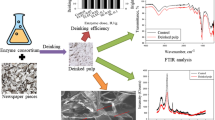Abstract
In this study, a chemical reduction strategy was explored for deinking of newspaper waste using xylano-pectinolytic catalysts. A remarkable reduction of 40% in toxic chemicals consumption was obtained by introducing this enzymatic approach of deinking along with improved level of various physical and optical properties. Similarly, a reduction of 18.89% and 17.68% in BOD, COD values of effluent has also been noticed. This combined deinking methodology also resulted in a gain of 5.82% in breaking length, 6.45% in tear factor, 8.57% in burst factor and 9.64% in viscosity, which greatly improved the quality of the handsheets. The study revealed that enzymatic deinking followed by chemical deinking with 40% less chemicals consumption, could be an effective method for reducing the negative impact over the environment caused by 100% deinking chemicals. This is the first report of newspaper waste deinking using xylano-pectinolytic catalysts produced concurrently in the same production media by a bacterial isolate using agricultural wastes as carbon sources.
Similar content being viewed by others
References
Chutani P, Sharma KK (2015) Biochemical evaluation of xylanases from various filamentous fungi and their application for the deinking of ozone treated newspaper pulp. Carbohydr Polym 127:54–63
Das A, Paul T, Halder KS, Jana A, Maity C, Das PK, Pati MB, Mondal KC (2013) Production of cellulolytic enzymes by Aspergillus fumigatus ABK9 in wheat bran-rice straw mixed substrate and use of cocktail enzymes for deinking of waste office paperpulp. Biores Technol 128:290–296
Desai DI, Iyer BD (2016) Biodeinking of old newspaper pulp using a cellulase-free xylanase preparation of Aspergillus niger DX-23. Biocatal Agric Biotechnol 5:78–85
Hong R, Su L, Chen S, Long Z, Wu J (2017) Comparison of cutinases in enzymic deinking of old newsprint. Cellulose 24:5089–5099 https://doi.org/10.1007/s10570-017-1424-5
Ibara D, Monte MC, Blanco A, Martinez AT, Martinez MJ (2012) Enzymatic deinking of secondary fibres: cellulases/hemicellulases versus laccase-mediator system. J Ind Microbiol Biotechnol 39:1–9
Kaur A, Singh A, Dua A, Mahajan R (2017) Cost effective and concurrent production of industrially valuable xylano-pectinolytic enzymes by a bacterial isolate Bacillus pumilus AJK. Prep Biochem Biotech 47:8–18
Kumar V, Satyanarayana T (2014) Production of endoxylanase with enhanced thermostability by a novel polyextremophilicBacillus halodurans TSEV1 and its applicability in waste paper deinking. Proc Biochem 49:386–394
Kumar A, Dutt D, Gautam A (2016) Production of crude enzyme from Aspergillus nidulans AKB-25 using black gram residue as the substrate and its industrial applications. J Genet Eng Biotechnol 14:107–118
Lee CK, Darah I, Ibrahim CO (2007) Enzymatic deinking of laser printed office waste papers: some governing parameters on deinking efficiency. Bioresour Technol 98:1684–1689
Lee CK, Ibrahim D, Omar IC (2013) Enzymatic deinking of various types of waste paper: efficiency and characteristics. Proc Biochem 48:299–305
Miller GL (1959) Use of dinitrosalicylic acid reagent for determination of reducing sugar. Anal Chem 31:420–428
Pala H, Mota M, Gama FM (2006) Factors influencing MOW deinking: laboratory scale studies. Enzyme Microb Technol 38:81–87
Park J, Park K (2001) Improvement of the physical properties of reprocessed paper by using biological treatment with modified cellulase. Bioresour Technol 79:91–94
Soni R, Nazir A, Chadha BS (2010) Optimization of cellulase production by a versatile Aspergillus fumigatus fresenius strain (AMA) capable of efficient deinking and enzymatic hydrolysis of Solka floc and bagasse. Ind Crops Prod 31:277–283
TAPPI test methods (1996) Technical association of the pulp and paper industry. TAPPI Press, Atlanta
Viesturs U, Leite M, Eisimonte M, Eremeewa T, Treimanis A (1999) Biological deinking technology for the recycling of waste office papers. Bioresour Technol 67:255–265
Virk AP, Puri M, Gupta V, Capalash N, Sharma P (2013) Combined enzymatic and physical deinking methodology for efficient eco-friendly recycling of old newsprint. Plos One 128:290–296
Vyas S, Lachke A (2003) Biodeinking of mixed office waste paper by alkaline active cellulases from alkalotolerant Fusarium sp. Enzyme Microb Technol 32:236–245
Xu Q, Fu Y, Gao Y, Qin M (2009) Performance and efficiency of old newspaper deinking by combining cellulase/hemicellulase with laccase–violuric acid system. Waste Manag 29:1486–1490
Xu QH, Wang YP, Quin MH, Fu YJ, Li ZQ, Zhang FS, Li JH (2011) Fibre surface characterization of old newsprint pulp deinked by combining hemicellulase and laccase mediator system. Bioresour Technol 102:6536–6540
Zhang X, Renaud S, Paice M (2008) Cellulase deinking of fresh and aged recycled newsprint/magazines (ONP/OMG). Enzyme Microb Technol 43:103–108
Acknowledgements
The financial support (Grant number: HSCST/2258) provided by Department of Science and Technology, Government of Haryana, India is greatly acknowledged.
Author information
Authors and Affiliations
Corresponding author
Ethics declarations
Conflict of interest
Authors declare no conflict of interest concerning the publication of this article.
Rights and permissions
About this article
Cite this article
Singh, A., Kaur, A., Yadav, R.D. et al. An efficient eco-friendly approach for recycling of newspaper waste. 3 Biotech 9, 51 (2019). https://doi.org/10.1007/s13205-019-1590-2
Received:
Accepted:
Published:
DOI: https://doi.org/10.1007/s13205-019-1590-2




